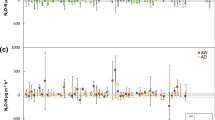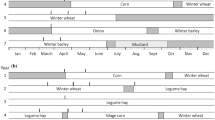Abstract
The aim of the present work was to estimate the contribution of different point and diffuse sources to the regional N2O emission strength of steppe in the Xilin river catchment, Inner Mongolia, People’s Republic of China. Transect studies showed that the topographic effect on N2O emissions from upland soils was negligible and that upland steppe is only a very weak net source of N2O during the growing season (0.8 ± 0.4 μg N2O–N m−2 h−1). Slightly higher emissions were found for riparian areas (1.8 ± 0.3 μg N2O–N m−2 h−1), which cover ∼4% of the landscape. Even faeces or urine additions stimulated N2O emissions from steppe soils only weakly (<2.5 μg N2O–N m−2 h−1 for a 5 days period). Due to low moisture contents, N2O emissions from dung heaps were also rather low (6.2 ± 0.8 μg N2O–N kg−1 dry matter h−1). In contrast, three orders of magnitude higher N2O emissions were found at sheepfolds (2.45 mg N2O–N m−2 h−1 on average). By calculating N2O emissions on a landscape scale, we show that point sources, and especially sheepfolds, become the dominating regional N2O source during the growing season if stocking rates are >1 sheep ha−1. Our results indicate that the common grazing management in the Xilin river region leads to a translocation of nitrogen from large source areas towards defined spots. This finding is further supported by measurements of NH3 concentrations at different sites. Since most of the nitrogen accumulated in these hot spots is finally lost through burning of the dried excrements by the farmers for heating and cooking purposes, the ecosystem faces a significant human perturbation of regional N cycling, which may contribute to an accelerated degradation of steppe in the Xilin river region.








Similar content being viewed by others
References
Breuer L, Papen H, Butterbach-Bahl K (2000) N2O emissions from tropical forest soils of Australia. J Geophys Res 105:26353–26367
Bristow AW, Whitehead DC, Cockburn JE (1992) Nitrogenous constituents in the urine of cattle, sheep and goats. J Sci Food Agric 59:387–394
Butterbach-Bahl K, Gasche R, Breuer L, Papen H (1997) Fluxes of NO and N2O from temperate forest soils: impact of forest type, N deposition and of liming on the NO and N2O emissions. Nutr Cycl Agroecosys 48:79–90
Carter MS, Klumpp K, Le Roux X (2006) Lack of increased availability of root-derived C may explain the low N2O emission from low N-urine patches. Nutr Cycl Agroecosys 75:91–100
Chen GX, Huang B, Xu H, Zhang Y, Huang GH, Yu KW, Hou AX, Du R, Han SJ, van Cleemput O (2000) Nitrous oxide emissions from terrestrial ecosystems in China. Chemosphere–Glob Change Sci 2:373–378
Clough TJ, Kelliher FM, Sherlock RR, Ford CD (2004) Lime and soil moisture effects on nitrous oxide emissions from a urine patch. Soil Sci Soc Am J 68:1600–1609
Corre MD, van Kessel C, Pennock DJ (1996) Landscape and seasonal patterns of nitrous oxide emissions in a semiarid region. Soil Sci Soc Am J 60:1806–1815
Corre MD, Schnabel RR, Stout WL (2002) Spatial and seasonal variation gross nitrogen transformations and microbial biomass in a Northeastern US grassland. Soil Biol Biochem 34:445–457
Del Prado A, Merino P, Estavillo JM, Pinto M, Gonzalez-Murua C (2006) N2O and NO emissions from different N sources and under a range of soil water contents. Nutr Cycl Agroecosys 74:229–243
Dittert K, Lampe C, Gasche R, Butterbach-Bahl K, Wachendorf M, Papen H, Sattelmacher B, Taube F (2005) Short-term effects of single or combined application of mineral N fertilizer and cattle slurry on the fluxes of the radiatively active trace gases from grassland soil. Soil Biol Biochem 37:1665–1674
Du R, Lu D, Wang G (2006) Diurnal, seasonal, and inter-annual variations of N2O fluxes from native semi-arid grassland soils of Inner Mongolia. Soil Biol Biochem 38:3474–3482
Epstein HE, Burke IC, Moiser AR, Hutchinson GL (1998) Plant functional type effects on trace gas fluxes in the shortgrass steppe. Biogeochemistry 42:145–168
Flora of China (2006) Poaceae, vol 22. Beijing, St. Louis, pp 206–211
Holst J, Liu C, Brüggemann N, Butterbach-Bahl K, Zheng X, Wang Y, Han S, Yao Z, Jin Y, Han X (2007) Microbial N turnover and N-oxides (N2O/NO/NO2) fluxes in semi-arid grassland of Inner Mongolia. Ecosystems, doi: 10.1007/s10021-007-9043-x
Huang B, Chen G, Huang G, Hauro T (2003) Nitrous oxide emission from temperate meadow grassland and emission estimation for temperate grassland of China. Nutr Cycl Agroecosys 67:31–36
IPCC (2006) Intergovernmental panel on climate change. Guidelines for national greenhouse gas inventories Agriculture, forestry and other land use, vol 4. http://www.ipcc-nggip.iges.or.jp/public/2006gl/index.htm
Kawamura K, Akiyama T, Yokota H, Tsutsumi M, Yasuda T, Watanabe O, Wang S (2005) Quantifying grazing intensities using geographic information systems and satellite remote sensing in the Xilingol steppe region, Inner Mongolia, China. Agric Ecosyst Environ 107:83–93
Kool DM, Hoffland E, Hummelink EWJ, van Groeningen JW (2006) Increased hippuric acid content of urine can reduce soil N2O fluxes. Soil Biol Biochem 38:1021–1027
Krupa SV (2003) Effects of atmospheric ammonia (NH3) on terrestrial vegetation: a review. Environ Pollut 124:179–221
Lavrenko EM, Karamysheva ZV (1993) Steppes of the former Soviet Union and Mongolia. In: Coupland RT (ed) Natural grasslands. Eastern hemisphere and résumé. Ecosystems of the world, vol 8B. Elsevier, Amsterdam, London, New York, Tokyo, pp 3–59
Liang E, Vennetier M, Lin J, Shao X (2003) Relationships between tree increment, climate and above-ground biomass of grass: a case study in the typical steppe, north China. Acta Oecol 24:87–94
Lovell RD, Jarvis SC (1996) Effects of urine on soil microbial biomass, methanogenesis, nitrification and denitrification in grassland soils. Plant Soil 186:265–273
Ma X, Wang S, Wang Y, Nyren P (2006) Short-term effects of sheep excrement on carbon dioxide, nitrous oxide and methane fluxes in typical grassland of Inner Mongolia. New Zeal J Agric Res 49:285–297
Matson PA, Volkmann C, Coppinger K, Reiners WA (1991) Annual nitrous oxide flux and soil nitrogen characteristics in sagebrush steppe ecosystem. Biogeochemistry 14:1–12
Milchunas DG, Parton WJ, Bigelow DS, Schimel DS (1988) Factors influencing ammonia volatilization from urea in soils of the shortgrass steppe. J Atmos Chem 6:323–340
Mosier A, Schimel D, Valentine D, Bronson K, Parton W (1991) Methane and nitrous oxide fluxes in native, fertilized and cultivated grasslands. Nature 350:330–332
Mosier AR, Parton WJ, Phongpan S (1998) Long-term large N and immediate small N addition effects on trace gas fluxes in the Colorado shortgrass steppe. Biol Fertil Soils 28:44–50
Mosier AR, Morgan JA, King JY, LeCain D, Milchunas DG (2002) Soil-atmosphere exchange of CH4, CO2, NOX, and N2O in the Colorado shortgrass steppe under elevated CO2. Plant Soil 240:201–211
Mummey DL, Smith JL, Bolton H (1994) Nitrous oxide flux from a shrub-steppe ecosystem: sources and regulation. Soil Biol Biochem 26:279–286
Nömmik H (1956) Investigations on denitrification in soil. Acta Agric Scand 6:195–228
Papen H, Butterbach-Bahl K (1999) A 3-year continuous record of nitrogen trace gas fluxes from untreated and limed soil of a N-saturated spruce and beech forest ecosystems in Germany. 1. N2O emissions. J Geophys Res 104:18487–18503
Petersen SO, Stamatiadis S, Christofides C (2004) Short-term nitrous oxide emissions from pasture soil as influenced by urea level and soil nitrate. Plant Soil 267:117–127
Qian Z (2002) The status of stockbreeding and tourism in Xilingol biosphere reserve. College of Environmental Science, Beijing University, Beijing (http://www.unesco.org/mab/BRs/q_e/case_studies/statusreport.pdf)
Ripley EA (1992) Grassland climate. In: Coupland RT (ed) Natural grasslands. Introduction and western hemisphere. Ecosystems of the world, vol 8A. Elsevier, Amsterdam, London, New York, Tokyo, pp 7–24
Schimel DS, Parton WJ, Adamsen FJ, Woodmansee RG, Senft RL, Stillwell MA (1986) The role of cattle in the volatile loss of nitrogen from a shortgrass steppe. Biogeochemistry 2:39–52
Skiba U, DiMarco C, Hargreaves K, Sneath R, McCartney L (2006) Nitrous oxide emissions from a dung heap measured by chambers and plume methods. Agric Ecosyst Environ 112:135–139
Sutton MA, Miners B, Tang YS, Milford C, Wyers GP, Duyzer JH, Fowler D (2001) Comparison of low cost measurement techniques for long-term monitoring of atmospheric ammonia. J Environ Monit 3:446–453
Tang YS, Sutton MA (2003) A new passive sampler for long-term ambient monitoring of atmospheric ammonia. Diffusive Monit 14:7–8
Tong C, Wu J, Yong S, Yang J, Yong W (2004) A landscape-scale assessment of steppe degradation in the Xilin River Basin, Inner Mongolia, China. J Arid Environ 59:133–149
van Groeningen JM, Velthof GL, van der Bolt FJ, Vos A, Kuikman PJ (2005) Seasonal variation in N2O emission from urine patches: effects of urine concentration, soil compaction and dung. Plant Soil 273:15–27
van Groeningen JM, Palermo V, Kool DM, Kuikman PJ (2006) Inhibition of denitrification and N2O emission by urine-derived benzoic and hippuric acid. Soil Biol Biochem 38:2499–2502
Verhagen FJM, Laanbroek HJ, Woldendorp JW (1995) Competition for ammonium between plant roots and nitrifying and heterotrophic bacteria and the effects of protozoan grazing. Plant Soil 170:241–250
Wang YS, Wang YH (2003) Quick measurement of CH4, CO2 and N2O emissions from a short-plant ecosystem. Adv Atmos Sci 20:842–844
Wang Y, Xue M, Zheng X, Ji B, Du R, Wang Y (2005a) Effects of environmental factors on N2O emission from and CH4 uptake by the typical grasslands in the Inner Mongolia. Chemosphere 58:205–215
Xu-Ri, Wang R, Zheng X, Ji B, Wang M (2003) A comparison between measured and modeled N2O emissions from Inner Mongolian semi-arid grassland. Plant Soil 255:513–528
Yamulki S, Jarvis S C, Owen P (1998) Nitrous oxide emissions from excreta applied in a simulated grazing pattern. Soil Biol Biochem 30:491–500
Zhu TC (1993) Grasslands of China. In: Coupland RT (ed) Natural grasslands. Eastern hemisphere and résumé. Ecosystems of the world, vol 8B. Elsevier, Amsterdam, London, New York, Tokyo, pp 61–82
Acknowledgements
This work was financed by Deutsche Forschungsgemeinschaft (DFG) as part of the Research Unit 536 “Matter fluxes in grasslands of Inner Mongolia as influenced by stocking rate” (MAGIM). We thank Zhihong Yu, Shubin Yu and Jia Deng for their assistance in gas sampling and analysis. Thanks also go to Bettina Ketzer, Katrin Schneider, Thomas Glindemann for providing additional information and to Yuandi Zhu for her logistical support.
Author information
Authors and Affiliations
Corresponding author
Additional information
Responsible Editor: Per Ambus.
Rights and permissions
About this article
Cite this article
Holst, J., Liu, C., Yao, Z. et al. Importance of point sources on regional nitrous oxide fluxes in semi-arid steppe of Inner Mongolia, China. Plant Soil 296, 209–226 (2007). https://doi.org/10.1007/s11104-007-9311-8
Received:
Accepted:
Published:
Issue Date:
DOI: https://doi.org/10.1007/s11104-007-9311-8




